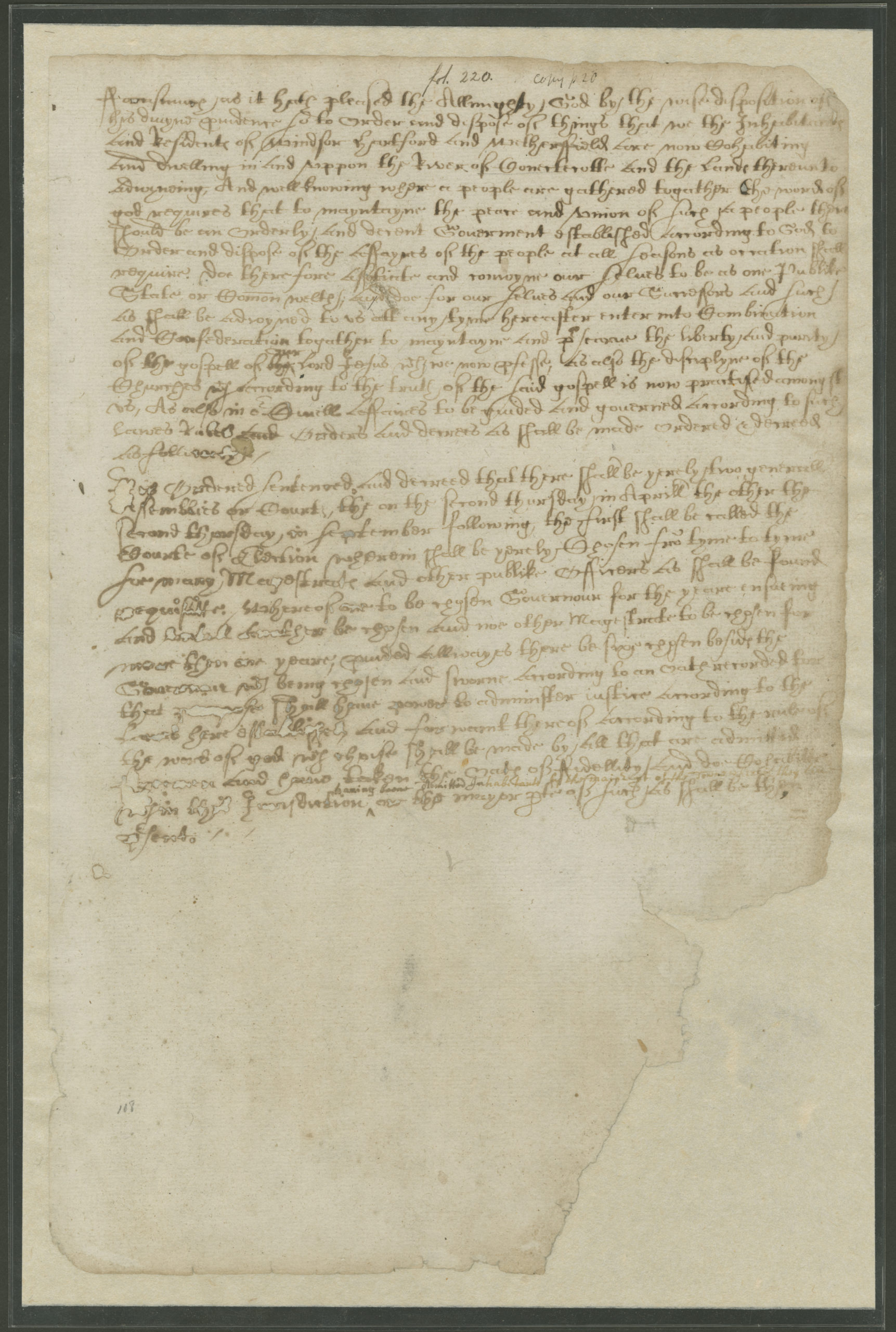by Rebecca Furer for Teach It
TEACHER'S SNAPSHOT
Subjects:
Belief & Religion, Civics, Colonial History, Law, Politics & Government, Rights & Responsibilities of Citizens, Voting & Suffrage
Course Topics/Big Ideas:
Role of Connecticut in U.S. History
Town:
Hartford, Statewide, Wethersfield, Windsor
Grade:
Grade 5
Lesson Plan Notes
The Fundamental Orders provided the framework for the government of Connecticut Colony—originally just the towns of Windsor, Hartford, and Wethersfield—from 1639 to 1662. The document was inspired by Thomas Hooker’s sermon of May 31, 1638, and consisted of a preamble and 11 “orders” (or laws). The Fundamental Orders spelled out when general courts should be held, how the governor and magistrates should be chosen, and who could vote. Although Connecticut was an English colony at the time, the document does not make any reference to the authority of the crown—only to that of God.
The Fundamental Orders identified two types of voters—“admitted inhabitants” and “freemen.” Not everyone living in a town was an “admitted inhabitant.” Paupers, itinerants, or other undesirable newcomers could be “warned off” from a town or refused admission. Adult male “inhabitants” could vote for local officials at town meetings and could also elect deputies to attend the General Court in Hartford. “Freemen” were a more selective group. Only they could serve as deputies and vote for the governor and magistrates. While in New Haven Colony only church members could become freemen, in the Connecticut Colony any adult man of good character with a certain amount of property could be admitted as a freeman, if he was willing and able to travel to Hartford to take the Oath of Loyalty and be sworn in by the General Court. Although there was nothing in Connecticut law until 1814 that said you must be white to be a freeman, there is no evidence that there were freemen of African descent in Connecticut in the 1600s.
It is largely thanks to the Fundamental Orders—considered by some to be the first written constitution in western democratic tradition—that Connecticut is nicknamed the “Constitution State.”
ESSENTIAL QUESTION
SUPPORTING QUESTIONS
- Why did the people of Connecticut create the Fundamental Orders?
- Why were the Fundamental Orders of Connecticut important and what do they tell us about colonial Connecticut?
- Who was allowed to vote under the Fundamental Orders? Who was not allowed to vote?
- Who should be allowed to participate in government/civic life?
ACTIVITY
1) Open with a discussion of who makes rules and laws that affect the kids in your class. Why do these rules and laws exist? What would happen without rules and laws? How can people work to change rules or laws that they think are unfair?
2) Next, move on to a discussion about who made the rules and laws that governed the various American colonies. (Note: While some colonies were governed directly through a royal charter, Connecticut did not have a charter until 1662.)
3) Introduce the Fundamental Orders as one of the founding documents in Connecticut history, although one that can be difficult to understand. Project the image of at least the first page of the document. Ask students to make observations.
4) Having students working individually, in pairs, or groups, distribute the sets of “What it says…”/”What it means…” cards. Give students time to read and try to match the original language of the document with its meaning.
5) Ask students what they could figure out about how Connecticut Colony was organized and governed in the 1600s. Address some of the supporting or compelling questions and solicit additional questions from the class. Discuss how and where students could find answers.
6) Wrap up by brainstorming some later documents that changed how the colony—or later the state and nation—were governed (e.g. Charter of 1662, United States Constitution, Connecticut Constitution of 1818, Connecticut Constitution of 1965.)
OPPORTUNITIES FOR ASSESSMENT
- Based on their study of the Fundamental Orders and other background information (available through the sources listed below or in the Teacher Snapshot above), as well as an investigation of voting requirements today, students will make a graphic organizer comparing who could (and could not) vote in Connecticut in 1639 with who can (and cannot) vote in Connecticut today.
- Students will research the history of voting rights in the United States and create a timeline showing when different groups achieved (or lost) the right to vote.
- Working individually or in groups, students will create a charter/constitution for their classroom, including a process for how new rules can be introduced and how rules considered unfair can be challenged.
RESOURCE TOOL KIT
Things you will need to teach this lesson:

Fundamental Orders of 1639. RG 001:001 Records of the Colony of Connecticut, State Archives, Connecticut State Library.
You can view the rest of the original document here:
Full text of the Fundamental Orders is available through The Avalon Project: Documents in Law, History and Diplomacy, Lillian Goldman Law Library, Yale Law School.

“What it says…”/”What it means…” Fundamental Orders Cards. Print enough single-sided copies for each student or group of students. Cut each set into two piles of cards—one for “What it says…” and one for “What it means…”
ADDITIONAL RESOURCES
Places to GO
Liberties & Legends Exhibit: Museum of Connecticut History
Henry Whitfield State Museum (Connecticut’s oldest house, 1639), Guilford, CT
Things To DO
For great educational programs and activities related to civics and government in Connecticut from the 1600s to today, check out one of the following:
- Museum of Connecticut History, where you can see some of Connecticut’s founding documents.
- Connecticut Museum of Culture and History’s “The Legend of the Charter Oak” role-playing program.
- Connecticut’s Kid Governor, a national award-winning statewide civics program created by the Connecticut Public Affairs Network (CPAN).
- Connecticut State Capitol Tours, operated by the League of Women Voters of Connecticut.
Websites to VISIT
“The Avalon Project: Fundamental Orders of 1639.” Yale Law School, 2016.
Articles to READ
ConnecticutHistory.org:
- “The Fundamental Orders of Connecticut.” by Bruce P. Stark, excerpted from Connecticut History and Culture: An Historical Overview and Resource Guide for Teachers (1985), edited by David Roth.
- “Creative License, or Fundamental Fact?” by Walter Woodward. © Connecticut Explored. All rights reserved. This article originally appeared in Hog River Journal (currently Connecticut Explored) Vol. 3/ No. 4, FALL 2005.
- “Thomas Hooker: Connecticut’s Founding Father” by Nancy Finlay.
- “The Importance of Being Puritan: Church and State in Colonial Connecticut” by Nancy Finlay.
- “The Charter of 1662” by Bruce P. Stark, excerpted from Connecticut History and Culture: An Historical Overview and Resource Guide for Teachers (1985), edited by David Roth.
“Voting in Early America” by Ed Crews. The Colonial Williamsburg Journal, Spring 2007.



